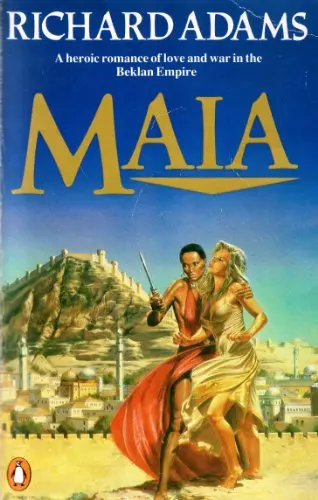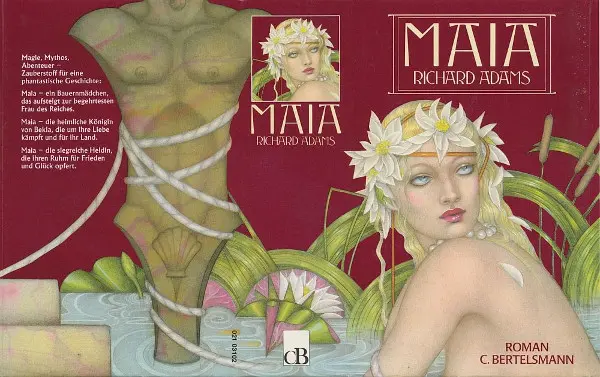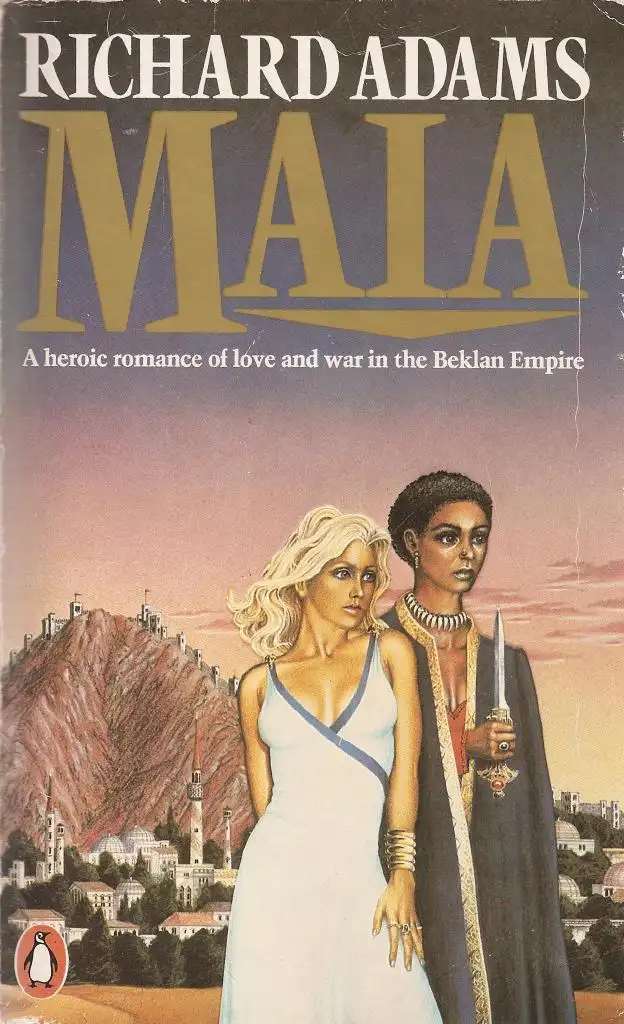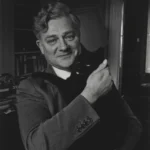In This LitStack Review of Maia
Introduction to the Novel Maia by Richard Adams
Maia, is a captivating, epic fantasy novel, written by Richard Adams, that takes readers on an adventurous journey through his richly detailed fictional and somewhat ebulliently decorated sexual underworld of The Beklan Empire. Published in 1984, Maia stands as a departure from Adams’ more well-known works like Watership Down and Plague Dogs. While it did not achieve the same level of commercial success as its predecessor, the epic fantasy Maia received critical acclaim for its meticulously crafted universe and engrossing storyline.
Despite its initial release being met with moderate success, Maia has since garnered a dedicated following among fans of epic fantasy. More than sorcerers and mages, the novel depicts a heroine sold into sexual slavery, who becomes a concubine. The novel is forthright in its depiction of sexual material, and it is depicted as being an ungainly commodity in the class structure and society of this fictional world.
However, within this richly detailed, despotic world, the novel presents a sprawling narrative that immerses readers in the exotic customs and traditions of the cultures in its fictional realm. Adams showcases his versatility as an author by seamlessly blending elements of historical fiction with fantastical world-building. Through intricate character development and vivid descriptions, he creates immersive characters, drawing the reader into the sexual, political and power intrigues and personal struggles that drive the story and Maia forward.
Maia remains a hidden gem in Adams’ literary repertoire. Its intricate storytelling, immersive world-building, and attention to detail have solidified its status among fans of epic fantasy novels. By diving headfirst into this enchanting tale filled with complex characters and gripping plotlines, readers can discover a whole new side to Richard Adams’ extraordinary talent as a writer.
One of the most striking elements of the novel is Adams’ masterful use of language. His vivid descriptions and evocative prose transport readers to the heart of the Beklan Empire, immersing them in the sights, sounds, and atmosphere of this richly imagined world. Adams’ ability to capture the nuances of human emotion and motivation is also remarkable, as he delves into the complex relationships and inner struggles of his characters.
The novel also explores various themes that resonate with readers, such as the resilience of the human spirit, the power of love and friendship, and the struggle for justice in an unjust world. Adams’ ability to seamlessly blend these themes into the narrative adds depth and meaning to the story, making it both entertaining and thought-provoking.
Overall, Maia is a captivating novel that showcases Richard Adams’ exceptional storytelling skills and his ability to create immersive worlds populated by complex and relatable characters. The novel’s rich language, intricate plot, and thought-provoking themes make it a truly memorable reading experience.
World Building: Description and Analysis of the World Building in Maia
In Maia, author Richard Adams masterfully constructs a vivid and intricate world that becomes just as much of a character in the story as the protagonist herself. Through meticulous attention to detail and immersive descriptions, Adams creates an otherworldly realm that feels both familiar and alien at the same time. From the lush landscapes of vibrant flora and fauna to the towering cities with their bustling markets and winding alleyways, every aspect of this world feels fully realized.
What sets Maia apart from other works of fantasy is how Adams utilizes setting to convey not only a sense of place but also a reflection of the characters’ inner worlds. The richly depicted landscapes mirror the emotional states of the protagonists, from serene meadows during moments of tranquility to treacherous forests shrouded in darkness during times of conflict. This interplay between setting and character creates a deep connection between readers and the narrative, allowing us to truly immerse ourselves in this fantastical realm.
Moreover, Adams seamlessly weaves elements unique to this world into the storytelling. The complex social structures, and delicate balance between different nationalities contribute to making Maia feel like a living-breathing entity. By paying such meticulous attention to these minute details, Adams grants authenticity and depth to his novel–a testament not only to his skill as a world builder but also as an author who understands how deeply intertwined setting is with character development.
In essence, Maia stands out for its masterful depiction of a captivating world
Some Book Covers Of Maia Throughout Its Lifetime
Here are a few of the various book covers which have graced the covers of this wonderful novel, in this country and in others.
Plot Scope: Discussion of the Scope and Complexity of the Plot
Another captivating aspect of Maia is its intricate plot, which weaves together elements of adventure, political intrigue, sexual slavery, and personal transformation. The story follows the journey of Maia, a young peasant girl who is sold into sexual slavery and eventually becomes a concubine, and then a national heroine, the Serrelinda.
Maia, the epic novel by Richard Adams, immerses readers in a world of vast scope and complexity. Set in a meticulously crafted fantasy realm of The Beklan Empire, the plot invites readers to lose themselves in its intricate tapestry. At its core is Maia, a young orphaned girl thrust into a twisted web of politics and power struggles. As we follow her journey, we are not only drawn deeper into the intricate machinations of the ruling class, but also given glimpses into the lives of myriad other characters whose stories weave seamlessly together. Included among those characters is Sencho, the revolting chief of intelligence of the empire, who eventually buys and enslaves Maia. The other girls Occula, Queen Fornis, Meris, who aid and assist and try to stop Maia’s journey.
Adams masterfully captures the delicate balance between macro and microcosms within his story. On one hand, he delves deep into political intrigue on a grand scale—illuminating complex power dynamics. On the other hand, he invests the reader in Maia’s personal story of how she must grow and conform in order to eventually escape. The only way out and to escape her world, is for her to grow into a woman who can gain the trust of the very persons who she would destroy.
However, it is Adams’ attention to detail concerning even minor plotlines that truly engrosses readers. Every interaction holds significance; no character exists purely for decoration. Through subplots interwoven with Maia’s own tale—an ambitious woman leader grappling with loyalty issues or an enigmatic seafarer navigating treacherous waters —the author creates a rich tableau where every narrative thread pulses with life. The scope may be vast, but it is this meticulous care for individual stories that ensures Maia captivates from beginning to end.
Heroine Arc: Exploration of the Character Development and Growth of Maia, the Protagonist
In the novel Maia by Richard Adams, the character development and growth of Maia, the protagonist, is an extraordinary journey that captivates readers from start to finish. From a young and naive girl to a resilient and strong-willed woman, Maia undergoes a profound transformation that resonates with readers on multiple levels.
One aspect of Maia’s character development that stands out is her determination to navigate the challenges she faces throughout the novel. Despite being born into a world where women are marginalized and treated as commodities, Maia refuses to conform to societal expectations. Instead, she embraces her own agency and strives for personal freedom. This unwavering determination not only reflects her growth but also serves as an inspiration for readers who may find themselves trapped in oppressive circumstances.
Additionally, Adams masterfully explores how Maia’s understanding of power evolves over time. Initially introduced as someone who is easily swayed by others’ opinions and desires, Maia gradually learns to distinguish between genuine love and manipulative control. As she experiences betrayal and heartbreak, she becomes more discerning about those around her and forms stronger boundaries. This evolution showcases Adams’ talent for crafting complex characters that grow with each page turn.
In essence, Richard Adams intricately weaves a heroine arc like no other in his novel Maia. Through exploring Maia’s character development and growth – from her unyielding determination to defy societal norms to her newfound understanding of power dynamics – he elevates the story beyond simply entertainment value.
Maia and Shardik: The Jewels of the Beklan Empire
In Richard Adams’ novels Maia and Shardik, a stark distinction can be drawn in the thematic elements and character development. While both stories explore the flawed nature of human societies, Maia takes a more introspective approach to its protagonist’s journey. By delving into the complexities of class, gender roles, and power dynamics within a fictional world reminiscent of ancient Rome, Adams provides readers with rich social commentary. On the other hand, Shardik shifts gears to present a more fantastical narrative centered around an enormous bear seen as a deity by its followers.
One key difference between Maia and Shardik stems from their respective settings. Though both occur in The Beklan Empire, we are given vastly divergent views of that world. In Maia, Adams offers readers intricate details about the hierarchical structure of society in his fictional city-state. Through this lens, he deconstructs several themes such as sexism and abuse of power seamlessly interwoven into his captivating narrative. Conversely, Shardik introduces readers to a Bekland Empire that is an entirely different world, one immersed in spiritual beliefs where humans worship Shardik as their god-like figure. This shift from the political realm to one grounded in religious fervor allows Adams to explore questions about faith versus doubt and the lengths individuals will go for their beliefs.
Overall, while both Maia and Shardik showcase Richard Adams’ remarkable storytelling abilities, their differing themes and settings invite readers on distinct literary journeys that incite reflection on both societal constructs and spiritual matters. It’s a great idea to read both of them to fully immerse yourself in Adam’s fiction world of The Beklan Empire.
Final Thoughts on Maia and its Significance
In conclusion, Maia is not just a novel; it is an intricately woven tapestry of imagination, emotion, and social commentary. Its significance lies in its ability to transcend the boundaries of conventional fantasy literature. It challenges our perceptions of gender roles, power dynamics, and societal hierarchies through the lens of a young exile fighting for her place in a treacherous world.
Its place in the fantasy canon cannot be overstated. Maia introduces us to a protagonist who is relatable yet extraordinary, navigating a realm filled with political intrigue and cultural and societal complexities. The novel deftly intertwines themes of identity, inequality, and resilience into its narrative fabric with skillful prose that keeps readers engrossed from start to finish.
Maia‘s legacy lies in its ability to thrill readers and at the same time to ask them to question societal norms and explore potential for growth and change. As we bid farewell to this unforgettable tale, it is clear that Maia will forever hold a cherished place within the halls of fantasy literature as storytelling that balances rich world-building with thought-provoking introspection and thrilling adventure.
~ J.S. Hood
About Richard Adams, Author of Maia
Richard George Adams was an English novelist and writer of the books Watership Down, Maia, Shardik and The Plague Dogs. He studied modern history at university before serving in the British Army during World War II. Afterwards, he completed his studies, and then joined the British Civil Service.
Titles by Richard Adams
Other LitStack Resources
Be sure and check out other LitStack Reviews to find out what you should read. And also check out other articles by J.S. Hood.
As a Bookshop and Amazon affiliate, LitStack may earn a commission at no cost to you when you purchase products through our affiliate links.







